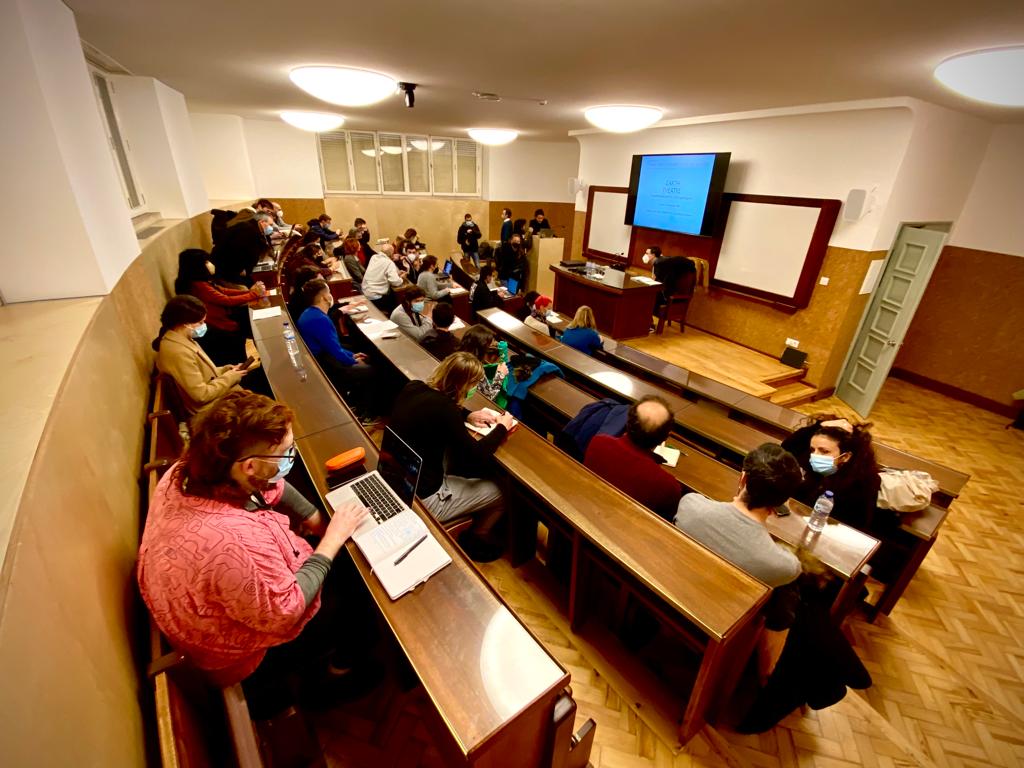Embora possamos identificar a presença da ciência no teatro praticamente desde o início da ciência moderna, o estudo académico sobre esta intersecção começou essencialmente já neste século. É um campo de investigação com cerca de duas décadas. Numa edição especial em dois volumes intitulados “New Directions in Theatre and Science” publicados na revista Interdisciplinary Science Reviews (2013 e 2014), as editoras convidadas, Kirsten Shepherd-Barr e Carina Bartleet, reuniram um conjunto de artigos que refletiam a vivacidade e diversidade desta área de investigação (essencialmente no mundo anglófono) e apontavam algumas das tendências futuras para as performances relacionadas com a ciência. Estes volumes, juntamente com vários encontros científicos sobre o tema tais como as conferências Communicating Science to the Public through the Performing Arts (Nova Iorque, 2010) e Performing Science: Dialogues Across Cultures (Lincoln/UK, 2014), constituem marcos importantes no estudo e reflexão neste campo.
+INFO
Universidade de Coimbra | Coimbra
25 a 27 de novembro de 2021
Bilhetes | Mediante inscrição
Folha de Sala
Este colóquio pretendeu continuar o caminho de mapeamento e reflexão sobre as intersecções entre o teatro e a ciência e promover a partilha e o ampliar do conhecimento neste campo, rastreando a evolução de tendências anteriores e identificando novos tipos de intersecções, e alargando a discussão a iniciativas não-anglófonas.
Uma perspetiva adicional que guiou o colóquio foi a de promover uma discussão ampla sobre este campo de intersecção, reunindo participantes tanto da área artística e da investigação em artes como da área da comunicação de ciência. As ligações interdisciplinares têm vindo a desenvolver-se dos dois lados, o artístico e o científico. A comunicação de ciência tem-se tornado cada vez mais essencial em contextos académicos e de investigação, e o teatro é uma das linguagens utilizadas nessa atividade.
O colóquio instigou e acolheu contribuições sobre os cruzamentos entre teatro e ciência relacionados com os dois lados desta equação, a prática artística e a comunicação de ciência. Os seus objetivos principais foram explorar os lugares em que teatro e ciência se encontram (assim como aqueles em que isso não acontece), bem como de provocar discussões frutíferas no sentido de esclarecer, eventualmente, as motivações e perspetivas que são comuns e as que são diversas.
QUANDO, COMO, PORQUE, ONDE… se encontram o teatro e a ciência?
O colóquio explorou temas como:
– Temas e conceitos científicos
– Formas e subgéneros teatrais
– Práticas contemporâneas no teatro sobre ciência
– Tendências futuras no teatro sobre ciência
– Processos de pesquisa em teatro vs processos de pesquisa científica
– O teatro na formação de investigadores científicos
– Financiamento nas artes e na ciência
E colocou questões como:
– Pode o teatro ajudar a resolver problemas científicos?
– O conhecimento científico transforma o teatro?
– Que tipos de públicos para as performances sobre ciência?
– O teatro faz sentido na comunicação de ciência?
– Que tipo de conhecimento sobre a ciência pode o teatro acrescentar?
– O teatro pode transformar o modo como os cientistas realizam as suas investigações?
– De que modo o teatro se envolve nos debates públicos sobre a ciência e o desenvolvimento científico?
– Pode o teatro inspirar novas investigações científicas?
Comissão Científica
Alex Mermikides (RU), Brian Schwartz (EUA), Carlos Fiolhais (PT), Daniel Gamito-Marques (PT), Joana Lobo Antunes (PT), Paul Johnson (RU)
Oradores Principais
Andrea Brunello (IT), Frédérique Aït-Touati (FR), Kirsten Shepherd-Barr (RU)
Comissão Organizadora
Mário Montenegro, Fernando Matos Oliveira, Teresa Girão, Sara Varela Amaral, Cláudia Morais, Francisca Moreira
Entidades parceiras
Faculdade de Letras da Universidade de Coimbra, SciComPT, Rádio Universidade de Coimbra, A Escola da Noite, Grémio Operário de Coimbra, Diário de Coimbra, Rómulo – Centro Ciência Viva, Instituto de Investigação Interdisciplinar da Universidade de Coimbra
Apoio
República Portuguesa — Cultura / Direção-Geral das Artes, Câmara Municipal de Coimbra, Fundação para a Ciência e a Tecnologia



